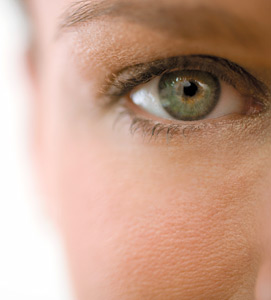A few years ago, I saw a short health segment on the evening news about training dentists to recognize the difference between patient fear and patient pain during dental procedures. The method was simple: watch the patient's eyes and eyebrows.
Despite the absence of a reference for this theory, there is a striking resemblance to it and the popular Wong-Baker pain scale. The Wong-Baker scale is a series of drawings that reflect progressing degrees of pain. The eyebrows are lower and more furrowed with each progressing degree of pain. The utility of this scale is helping gauge pain in children and those with poor reading abilities. The patient can select the facial expression that reflects how they feel, or in some cases the health care provider may have to select the expression. The facial expressions on the painful end of the Wong-Baker scale resemble the international biohazard symbol.
 In The Back Pain Revolution, Second Edition, Waddell reports on a study by Keefe and Block of overt (observable) signs of pain. The signs listed are guarding, bracing, rubbing, grimacing and sighing. Grimacing matches the dental theory and the Wong-Baker Scale. The eyes furrow with pain.
In The Back Pain Revolution, Second Edition, Waddell reports on a study by Keefe and Block of overt (observable) signs of pain. The signs listed are guarding, bracing, rubbing, grimacing and sighing. Grimacing matches the dental theory and the Wong-Baker Scale. The eyes furrow with pain.
There are facial muscles associated with these facial expressions. The relaxed obicularis oculi and the frontalis open the eyes raising the eyebrows with fear and excitement. Contracted obicularis oculi, procerus and corrugator muscles close the eyes and furrow the eyebrows with pain.
Orthopedic testing also has a few tests associated with facial expressions. Several tests include the word apprehension. The two most common are the Shoulder Apprehension Test and the Patellar Apprehension Test. Both are tests that might dislocate a joint that is subject to recurrent dislocation. The doctor is to watch the patient's facial expression while performing the tests. The expression represents the point at which the doctor is to stop the test short of the dislocation.
While only certain tests are described as apprehension tests, any test can cause the patient to look apprehensive if the patient fears the reproduction of pain they do not wish to experience. The novice examiner's most common mistake when performing apprehension tests is failing to watch the patient's facial expressions.
Evans, in his test Illustrated Orthopedic Physical Assessment, Third Edition, describes another sign of pain associated with the eyes: the stoicism index. The index is based on people with high pain tolerances not blinking as frequently as people with lower pain tolerances. Normal blinking averages every 25-30 seconds. Stoic individuals can go 60 seconds between blinks.
Stoic patients are interesting. Since they have a high pain tolerance, they seldom report pain, even if it is significant. This makes them less likely to seek health care, causes them to enter with conditions that may be more advanced; and reduces the likelihood of hypochondriac behavior. You could swat them with a baseball bat and not elicit much of a response. They do not feel the pain, so they do not complain or take action. They seldom claim a high pain tolerance and simply think that they just do not hurt.
This is directly opposed to patients with low pain tolerances. They frequently seek health care, even for minor problems, and can exhibit hypochondriac behavior. A light breeze can cause a major flare-up.
Click here for more information about K. Jeffrey Miller, DC, MBA.





